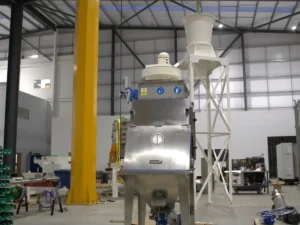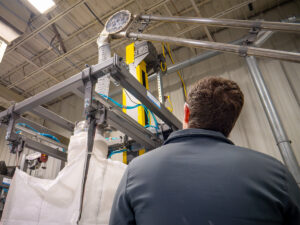Bulk bag discharge systems make transferring ingredients from bulk bags to mixing and blending equipment incredibly efficient, ensuring a steady flow of materials that increases production capacity with less manual labor.
But some bulk bag unloaders leave more to be desired when it comes to dust containment, ease of operation and accuracy of weighing material. These common issues slow production down and lead to wasted time and materials. Learn about these bulk unloader pitfalls – and how to avoid them – below.

Dust Leaking from the Bulk Bag Discharge Spout
Some bulk bag unloaders feature designs with weak seals or clamps that make it easy for dust to escape when connecting or disconnecting the bulk bag and the outlet spout. Depending on the exact chemical composition of the material, fugitive dust can cause problems ranging from safety and inhalation concerns for staff members to potential explosion hazards. Over time, it also contributes to product loss and labor waste in the form of unnecessary cleaning.
To steer clear of these issues, you should look for bulk bag unloaders that feature:
● A support dish with an outlet spout that passes through a flexible, dust-tight membrane.
● An “untie box” that, when connected to a dust collection system, allows the operator to open the spout without releasing any dust.
● Spout closure bars for easy bag untying and retying to ensure the bag remains closed until the emptying process starts.
Inconsistent Bulk Bag Placement
Unfortunately, bulk bag discharging equipment is often misused. How a bulk bag is placed on discharge equipment can vary significantly from operator to operator. Two primary reasons for this are poor equipment design and lack of proper training.
Operators should not have to reach under suspended bulk bags, contort themselves in an uncomfortable position to untie the bag outlet spout or put their hands or arms near any moving parts. Systems that are less operator friendly can also increase the time and effort it takes to load each bulk bag and negatively impact throughput rates.
To improve ease of use, consider bulk bag unloaders with:
● Properly designed support frames that take the shoulder height of the average human into account, reducing the need for bending and stretching.
● Integrated hoists that assist in lifting heavy bags and minimize manual handling.
● Bag untie boxes or access doors that make it easy for operators to untie the bag spout.
Inefficient or Inaccurate Weighing Methods
To keep profit margins high, food processors want to batch weigh as close to the exact amount of ingredients as possible. If you are off by as little as 2-5 pounds (sometimes less depending on the application), it can affect the quality and consistency of the batch and increase product waste.
You can increase accuracy by transferring material to a weigh feeder or weighing material in metal totes and carts, but those additional steps take time, increase capital cost and can decrease productivity.
To ensure efficient weighing, you should look for bulk bag unloaders that offer:
● A conveyor coupled to the base of the discharger for accurate metering of bulk bag contents.
● Load cells positioned directly under the bag support dish for more accurate reading of the weight of the bulk bag.
● Batch metering devices that are attached to the weighed portion of the bulk bag discharger frame instead of the discharge end of a conveyor and a non-weighed support.
Learn more about improving discharge productivity with automated bulk bag unloading technology:
How much does a bulk bag discharger cost?
Bulk bag discharger weight batching
3 Ways to Reduce Dusting When Discharging Bulk Bags






